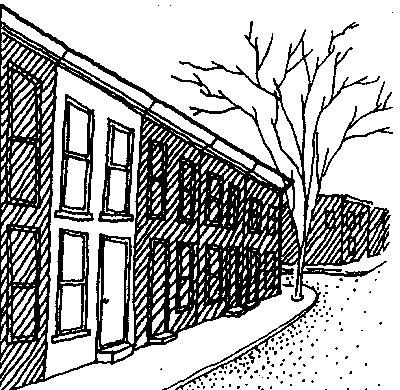
New Buildings
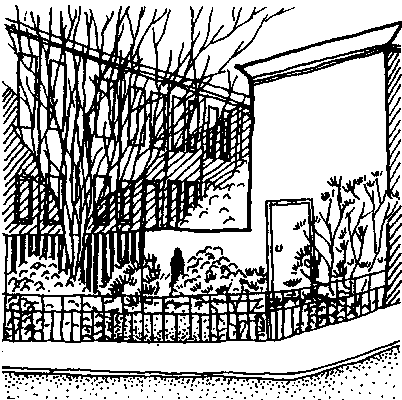
Private Gardens
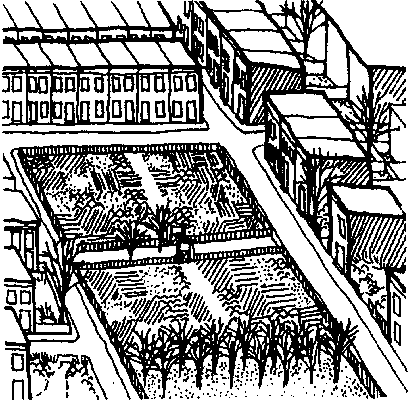
Community Gardens
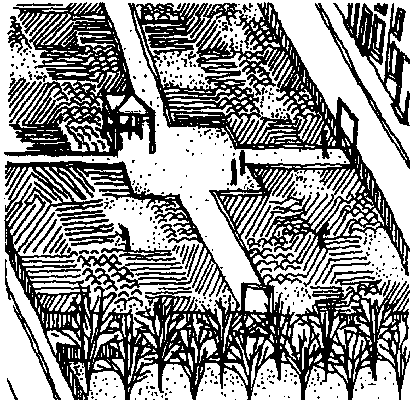
Meeting Place
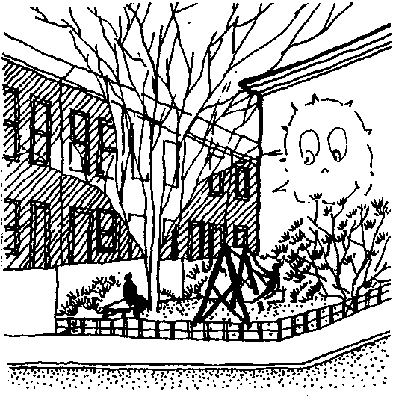
Playlot
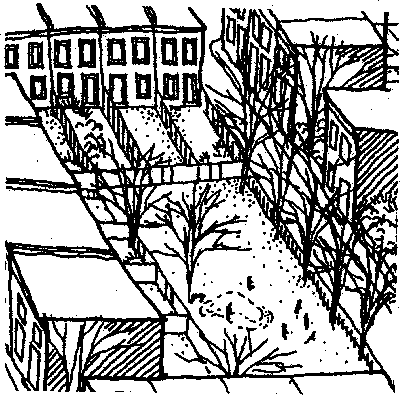
Playground and Ball Court
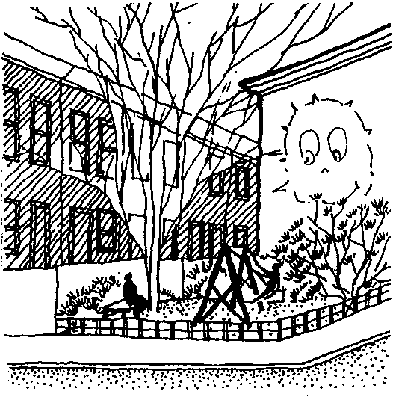
Playfield
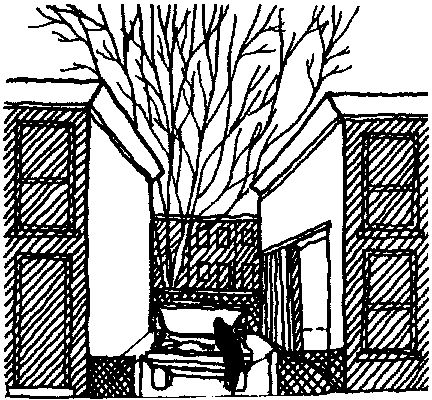
Outdoor Workshop
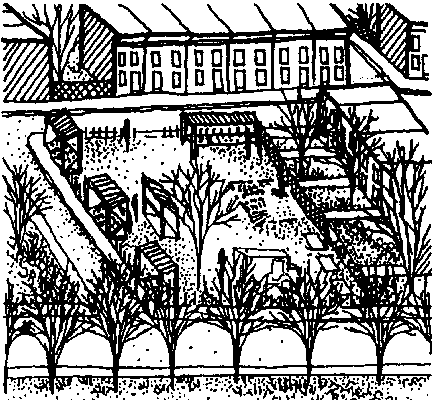
Outdoor Market
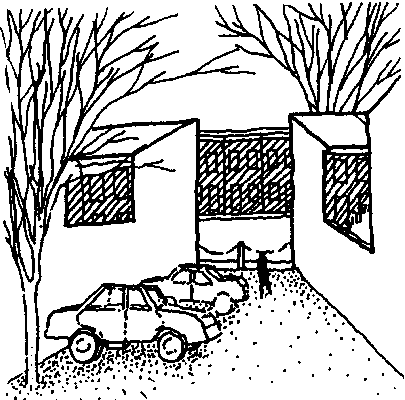
Parking Lot

Path
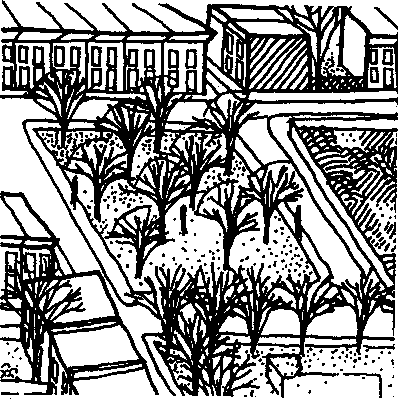
Orchard
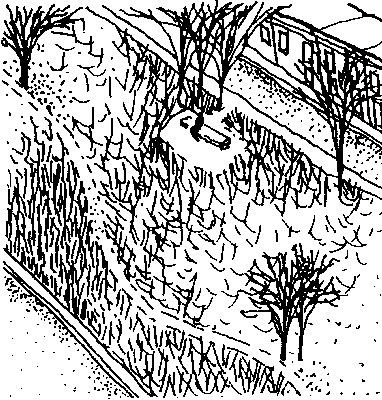
Meadow
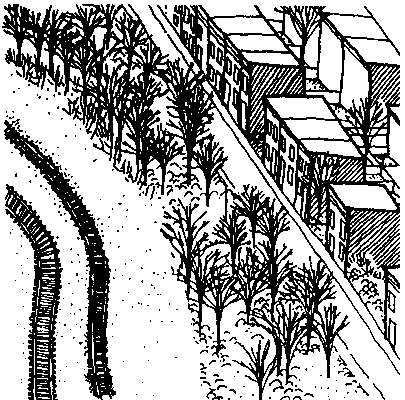
Grove
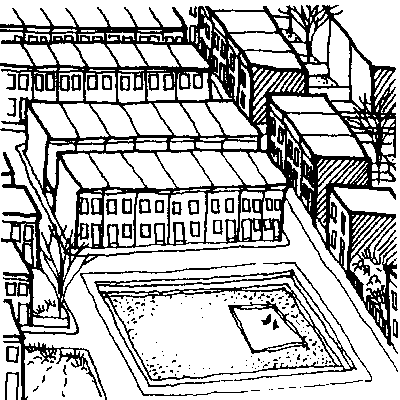
Flood Control and Storm Drainage

|
|
Vacant land affords an opportunity for the construction of new
buildings for housing, institutions, and businesses. New construction
for institutions and business is most likely to occur near existing
institutions like the University of Pennsylvania, the University City
Science Center, Presbyterian Hospital, or adjacent to existing churches
and other local organizations. Construction of new stores, office
buildings, small factories and warehouses may be built in existing
commercial and industrial areas. The vast majority of vacant land in
West Philadelphia, however, is in residential neighborhoods.
The construction of new, low-income housing will depend upon the
sponsorship of public agencies and private organizations.
New buildings in residential neighborhoods should be similar in scale to existing buildings and should reflect the qualities of the block or blocks within which they fit. Shaping the Block describes the types of blocks that occur in West Philadelphia, their features and social qualities. |
 |

|
|
A garden provides its owners with a outdoor space that they can shape to suit their own needs and taste. In
neighborhoods of single houses and duplexes, like Powelton, Spruce Hill,
and Garden Court, many homes have private gardens. But in other
neighborhoods, primarily those with rowhouses and large apartment
buildings, there may be no private outdoor space except for a porch or a
stoop. In neighborhoods of row houses with tiny yards or no yards at
all, the use of a vacant lot for a private garden may fill an important
need. In blocks with detached houses and larger yards, it
is less likely that adjacent owners will wish to extend their yard to
include the vacant property, especially if the lot is large and subject
to substantial taxes. A single missing tooth or corner lot is more likely to be adopted for a private garden than large vacancies that
include multiple properties.
|  |

|
|
A community garden is a microcosm of community. (See: This Garden is a Town). Typically, a community garden is
where a group of people garden together, each maintaining an individual
or family plot, while dividing responsibility for maintenance of common
areas including planting and weeding flower beds, cleaning paths, or
filling water barrels. Community gardens range in size from those that
occupy a single lot to gardens that take up an entire city block. They
may be tended by one or two individuals or accommodate fifty or more
gardeners.
Community gardens are usually bounded by an inexpensive fence, such as turkey-wire or chain-link, and a locked gate to which the gardeners have keys. The common areas include paths, a water source, a compost pile, and perhaps a flower bed within the interior of the garden or along the exterior fence. They may also include a bulletin board, meeting place, a cold-frame, or a greenhouse. Community gardens often include hand-crafted signs, gates, borders, planters, trellises, arbors, and benches. Community gardens evolve over time. They may look rather simple after the initial construction, but as individual gardeners contribute their own ideas and constructions, the garden takes on its own identity. |  |

|
|
A meeting place is a social space where people come together. It
may be as simple as a bench or as elaborate as a large plaza with many
benches and tables. Community gardens, playgrounds, playfields, and
outdoor workshops are also meeting places. Most community gardens have a special place set aside for gardeners to rest, sit,
talk, and hold occasional social events. Lots that connect blocks, that are developed as pathways, also provide a place for people to meet as they walk to and from their homes.
A meeting place provides a shared territory where people can come together. It is also a place to see and be seen. While meeting places may be many sizes and shapes, two common features are boundaries and seating areas. A meeting place can be as formal as benches under a trellis structure or gazebo, or as informal as a place to pull up a few folding chairs beneath the shade of some trees. A low fence that forms a boundary between the garden and street, can serve as a meeting place between a person inside the garden and a person passing by. |  |

|
|
In most West Philadelphia neighborhoods there is little outdoor space for small children. Many rowhouses have no front yards and only tiny paved back yards, so the sidewalk and the street may be
the only place for children to play. Playgrounds are few and far between
in most areas of West Philadelphia, and young children cannot travel far by themselves. In some neighborhoods, however, there are many missing-teeth vacant lots. Their small size represent an opportunity to provide a
territory off the street where children can play.
A playlot is a small area that "belongs" to a group of children. It may be a simple grassy area or may contain play structures. It should be easily recognized as belonging to a particular group of children in order to keep older children and outsiders from taking over the space. A boundary or fence will help establish the lot as a territory. |  |

|
|
Playgrounds and ball courts are places for active play.
Playgrounds are often associated with a school, and are generally used by
school children, although ball courts are often used by adults on
evenings and weekends. Playgrounds and ball courts may be larger than
playlots. Unlike the small scale and intimate character of the playlot,
playgrounds and ball courts are more public and are likely to be used by
an entire neighborhood, rather than a single block.
Playgrounds usually have large, paved areas and play equipment, like swings and climbing structures. Adventure playgrounds are unpaved and are full of old wood, tires, and other materials for children to build with. Ball courts include special equipment like tennis nets or basketball hoops; lines painted on pavement usually mark the boundaries of the court. Both playgrounds and ball courts are usually enclosed by a fence. |  |

|
|
Playfields are large open lots which children and adults use for
activities like tag and frisbee or organized sports like soccer
and baseball. Because of the specific size requirements for certain
types of sports fields, only multiple contiguous blocks or whole square
blocks will be suitable. Unlike the small scale and intimate character
of the playlot, the playfield is public and may be used by an entire
neighborhood.
The dominant feature of a playfield is its large, open character. Usually playfields have mown grass, but they can also include baseball fields. Often a playfield will have some type of boundary, such as a low fence with occasional openings, shrubs, or a row of trees. |  |

|
|
An outdoor workshop is a place where a single person or several
people can work. Often this activity revolves around the automobile and
should be large enough to accomodate car washing, maintenance, and
repair. In neighborhoods of rowhouses without driveways or garages, the
street may be the only place for such activities. This can be a problem
if there is too much traffic or inadequate space to work. A single
missing tooth can accomodate a workshop for one or two people, while a larger vacant lot can include workspace for several individuals plus a common space.
An outdoor workspace is usually enclosed by a fence and locked gate to which the users have a key. If the workshop is used by a single person, the lot may simply include a few chairs and a space to work. If the workshop is shared by a group of people there may be individual workspaces, as well as common areas like benches, a sheltered meeting place, or a storage space that can be locked. |  |

|
|
An outdoor market is a place where merchandise can be bought,
sold, or traded. It may be as simple as a place where a single
entrepreneur can pull up a truck and sell vegetables or it may be a site
for a regular flea market or farmers' market. A vacant lot on a busy corner is an ideal place for an outdoor market.
Outdoor markets can be many sizes and types. A single vendor may require little space, while a market that involves many vendors must be larger. To be successful, outdoor markets must be visible and accessible. A corner location permits both visibility and access from two directions. If the site is large or on a busy street, surrounded by other businesses, the market may be bounded by sidewalk and street on one side only. In order to protect the lot from dumping, it may be necessary to establish a definite boundary, such as bollards, a row of trees, or a fence. When the market is open, however, it is important for customers to be able to move freely. While many outdoor markets are known by word of mouth, a sign announces the name of the market, what is sold there, and the days and hours even when the market is closed. A border of trees, shrubs, or flowers will improve the appearance of the lot considerably and will also signal that something is happening here. If the market attracts a large number of customers and the size of the lot permits, some space may be set aside for parking. |  |

|
|
Even a small missing tooth vacant lot can work as a place to park one or more cars. Cars will be more protected on a missing tooth in the
middle of the block and will be less so on a corner lot. Large parking lots are a common use on land that has been cleared and is being held for
future development.
Parking lots can be many sizes and types. They may be as simple as a small lot covered with gravel for the use of one or more neighborhood residents, or as formal as a privately owned and operated enterprise with a paved surface and entry gate and/or guard. Parking lots can be ugly to look at, especially in a residential neighborhood. A border of shrubs or flowers along the sidewalk can improve its appearance greatly. Any effort to improve the lot beyond simple paving or fence is a sign of goodwill to those who live and work in the area. |  |

|
|
A path leads from one place to another Sometimes a path across a vacant lot provides a shortcut for
people in a neighborhood. Such paths tend to be less public than a
sidewalk and can provide a more pleasant place to walk than the street.
Some types of vacant lots make new connections between streets, through
the middle of a block (connectors), across the corner of a block
(vacant corners), or across whole empty blocks (vacant blocks).
Many such paths start as a line trampled among tall grasses, others are
maintained and planted. The success of such paths and whether neighbors
wish to encourage or discourage their use depends upon who uses the path
and whether people feel safe walking on it.
|  |

|
|
An orchard is a planted grove of fruit trees, such as peach, cherry,
or apple. An orchard may be small, just several trees maintained by a
few people, or it may be quite large. Orchards are often part of a
community garden, but a small orchard could also be planted in a private
yard. Fruit trees require a lot of sun, so a vacant corner or a large
missing tooth with southern exposure would be a good site for an orchard. Although orchards bear fruit, they also provide shade and can
be combined with other uses besides community and private gardens, such
as meeting places and paths.
Fruit trees can be delicate, especially when small. Until the trees grow large, orchards should be protected by a fence with a gate. It is also important to have a source of water for nurturing the trees when they are first planted. |  |

|
|
A meadow is an open field of tall grasses and wildflowers.
Although many people think wildflower meadows are beautiful when they see
them in the countryside, when they see the same kind of meadow on a vacant lot, they don't like it. Urban meadows have an image problem. They appear to be abandoned and derelict. In order for an
urban meadow to be successful, it should look intentional and cared for.
The boundary is the most important feature in making an urban meadow appear intentional. A well-maintained edge signals that someone is caring for the meadow. A fence or row of trees along the border of the lot will deter people from dumping trash on the site. A meadow can be treated as a single territory or it may have paths mown through it, a meeting place within, or it can be shaped into islands with clumps of vegetation surrounded by a mown area. Mown paths are simple features that can be changed frequently. Gravel or woodchips make more permanent paths. A meeting place can be a temporary feature, like a mown clearing, or a more permanent built structure. |  |

|
|
A grove is a stand of trees that grow close together. In a dense neighborhood of rowhouses and few street trees, a grove will help cool the surrounding blocks.
The boundary is one of the most important features in making a grove appear attractive. A well-maintained edge signals that someone is caring for it. A fence or a straight row of trees planted along the sidewalk will deter people from dumping trash on the lot. If the lot is large enough, a clearing in the woods can be a meeting place. |  |

|
Flood Control and Storm Drainage
|
The use of low-lying, vacant land for flood control and storm
drainage involves draining rainwater from streets, sidewalks, and parking
lots and preventing it from entering sewers right away by holding it in
small detention ponds. This will
help prevent flooding and improve water quality in the Schuylkill River
and it will make it more economical to treat sewage.
Land for storm drainage needs to be a relatively large, low-lying, open territory. Since land set aside for storm drainage is likey to have another use during dry periods, it will share many features that apply to that land use in other locations. |  |